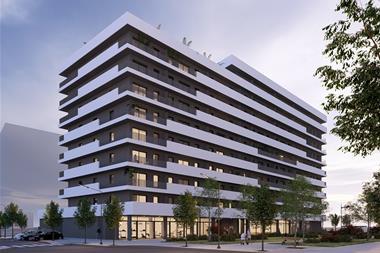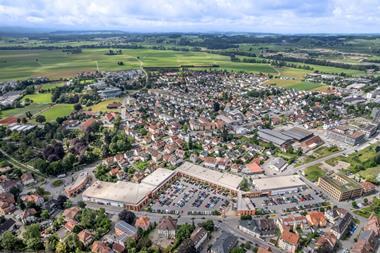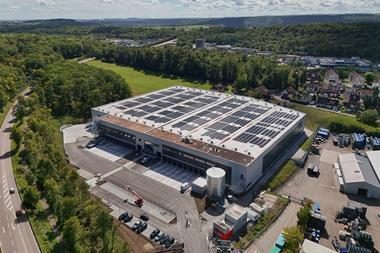Growing supply pressures in the domestic market are forcing home-loving Swiss pension funds to venture abroad, but the learning curve will be steep. Lynn Strongin Dodds reports
Real estate may be classified as an alternative asset class for many European pension funds but in Switzerland property has long been a mainstay of pension fund portfolios, alongside bonds and equities. The difference going forward is that the Swiss are slowly - and slowly is the operative word - venturing outside their borders in the name of diversification and higher returns.
According to Philip Rauh, Zurich-based vice-president, real estate solutions, at the asset management business of Credit Suisse, which manages real estate investment vehicles for many large pension funds, "the Swiss have a long history of investing in real estate; I think the first real estate fund was established in the late 1930s. It was never considered an alternative asset class but a classic mainstream investment. Real estate was typically viewed as a bond substitute because it is low risk and produces steady, stable cash flows. It is a core buy-and-hold investment."
In many ways, Swiss fund managers view the overseas component of the real estate portfolio as the alternative asset class because it has the potential to generate higher returns. The Swiss are fundamentally conservative investors and it is unlikely that they will become too adventurous. Although the trend to look for opportunities outside the country started about three years ago many, particularly small and medium-sized funds, are still mulling their options and the different products and strategies that are on the market.
Switzerland operates a three pillar system of state-provided, occupational and private pensions. On the corporate front, Swiss pension funds differ from those in other countries in that they are established as separate legal entities, independent of the sponsoring employer.
As a result, most companies have established ¬pension foundations that are managed by foundation boards with significant power over all funding decisions. They are appointed to define, implement and monitor plan design, including plan amendments, as well as investment policies. Also, employee representatives must have at least 50% of voting rights in most pension foundations, so employers have limited influence over their governance.
Rauh notes that while there are no concrete industry figures, estimates put the size of the Swiss pension fund industry at around SFr650bn (€390bn), of which about 15% is allocated to real estate. Domestic property comprises the bulk while foreign only accounts for 1%. About two-thirds are invested directly while one-third is in indirect funds or real estate investment trusts (REITs). Both types of investments are made via real estate investment funds, foundations or investment companies.
Swiss pension funds first invested in real estate about 30 years ago and a higher proportion invest in property than is the case elsewhere in Europe. According to a recent survey conducted by Mercer, which canvassed 574 European pension funds with assets totalling €364bn, 25% of UK funds have real estate holdings compared with 62% on average in continental Europe and Ireland. The figure for Switzerland was 68%.
Until recently, the industry took an insular view, and while there was much debate and discussion about extending horizons, very few pension funds made a move. In fact, as Rudolf Loertscher, managing director of UBS Global Asset Management, points out: "Pension funds liked to stay close to home and by this I mean that if the pension fund was located in Bern, for example, managers would first look for real estate opportunities just in the city. There is now a clear trend to look beyond the headquarters to not only the rest of the country but also internationally."
One of the reasons is that local property prices are increasing, which is putting pressure on yields and capital growth, although it is nowhere near the red-hot levels of the UK market. According to a report by UBS, Switzerland is mirroring the trends found in other foreign real estate markets. However, it points out that the trends are not as severe and that yield spreads are still higher in Switzerland than in many other countries.
"The real issue in the local market is that there are a limited number of local opportunities and there is now too much money chasing too few properties," Hermen Molendijk, managing director investor relations Europe at Arlington Securities, a European property fund manager, says.
"Also, as the real estate investment environment has become more transparent and liquid over the years, investors are much more comfortable looking overseas."
Eric Breval, manager of the Swiss AHV state social security fund, which has about SFr28bn of assets under management, agrees: "The concentration risk in the home market, which is relatively small, is growing. Prices have risen considerably and the yields are not what they used to be."
Pension fund reform has been another driver encouraging a wider property remit. Diversification is a theme being played out across Europe and Switzerland and has caught on to these wider industry trends. Over the last few years, there has been a raft of changes to the country's Occupational Pensions Act (BVG), enabling pension funds to shake up the asset class mix in a risk-controlled way. However, defined maximum limits were also set for each asset class.
For real estate, the boundaries mean that a maximum of 50% of a pension fund's assets may be invested in property in Switzerland. In addition to this, a maximum of 5% is allowed for direct or indirect property investments abroad. Pension funds could possibly go beyond the 5% limit if they could justify their strategies and show that the risk is under control. "The reasons might involve higher returns but at the moment, we do not see investors going above the current 5%," says Loertscher.
Altogether, material assets such as property or equities may not account for more than 70% of a fund's total assets.
It will take time for Swiss pension funds to move up the global property learning curve. Having focused on investing in local markets and in particular the residential end, industry participants believe an education process needs to take place to explain the different opportunities and challenges in the various countries.
Against this background, it is no wonder that the first and only step many pension funds are taking is through the indirect route, either via a REIT or a pan-European or a global real estate fund. Stephan Kloess, chief executive officer of Centre for Urban & Real Estate Management (CUREM) in Zurich, comments: "It is not possible to get a serious and effective diversification with worldwide direct investments. It is a matter of volume, manpower, time and resources.
"Regarding international property many pension funds see indirect investments as the most effective way. The main challenge for the future will be to build up the knowledge, and the resources to select the right vehicles and to monitor it appropriately."
Also, as Andreas Ammann, a partner with Wuest & Partner, one of Switzerland's largest real estate consultancies, points out: "It is also a question of diversification. If a pension fund invests directly in, for example, 10 properties, it will not provide the spread that they need across markets and sectors.
"It also takes a great deal of management time and energy to find the right opportunities, so they are turning to external managers. What we are seeing is an increased interest from the larger pension funds in asset management groups that offer a broad range of funds in different regions and with different
strategies."
Not surprisingly, pension funds are pursuing different strategies depending on their size and risk appetite.
Industry participants note that geographically there is a strong bias towards countries in the eurozone, while most are avoiding the UK because of its soaring property prices. There is also a lot of talk about central Europe and Asia, but so far there has been little action.
"Overall, we have seen a general shift towards investing in continental Europe, US and more recently Asia but it is happening very slowly," according to Markus Leuthard, senior investment manager at Avadis, a Baden-based fund management group that manages about SFr 6.5bn.
"We started investing abroad in 2000 because we wanted to reduce our home bias and add some diversification to the real estate portfolio. Our main thrust is in the US and Europe where we invest in REITs and other listed securities because they are liquid, cheap and tax efficient."
Avadis was set up as the internal asset manager for the SFr3.3bn Pensionskasse ABB, Baden, but now also runs about SFr885m for Pensionskasse Alstom Schweiz and SFr180m for Pensionskasse Bombardier Transportation (Switzerland) AG, among others.
AHV, however, started to invest in property four years ago and from the beginning looked at both global and domestic in tandem. It has 10% of its AUM in real estate and investments are spread across Switzerland, North America, Europe
and Asia.
The social security fund only invests indirectly because, as Breval notes: "Investing directly in real estate is typically characterised by low volatility. REITs, however, have had tremendous performance of 20-40% over the past years with abnormally low volatility."
Meanwhile, the Canton of Zurich Pension Fund (BVK), which is one of the country's largest, with SFr21.8bn in assets under management, is ready to explore a wider range of options. It is also a relative newcomer, having started to invest in global properties through its foundation in 2004. This year it decided to tap into the expertise of an external manager. Overall, real estate accounts for 17.3% of the portfolio although foreign properties represent just 1.2%.
According to Daniel Gloor, head of asset management at BVK, the target is to increase the overseas component to about 4%, although this could be raised to 5% later on.
The fund's criteria are that the domestic component should generate a net return of 5.5% while foreign properties should yield net returns of 6%. Unlike many pension funds, BVK is willing to consider opportunity funds which invest in higher risk/return properties such as hotels.
Gloor explains: "We want a mix of core holdings and those that have higher risk characteristics. For now we will be investing indirectly or through a limited partnership although REITs could be a possibility in the future. As for domestic investments, we will continue to look at residential and office properties in Zurich, Geneva and Bern."
For now, BVK is the exception rather than the rule in terms of opportunity funds; core and core plus remain dominant among Swiss pension funds. Loertscher says: "I think investing in opportunity funds will happen gradually because of the higher risk profile of the investments. At the moment, pension funds are discussing it but they are worried about the liquidity and the inability to get out easily. The other issue is where do some of these investments sit. For example, infrastructure could be real estate or private equity."
Industry participants all believe that pension funds will retain their conservative stance in the domestic market, with residential properties remaining the favourite due to their low risk profile. This is in sharp contrast to many other European markets where commercial and to a lesser extent retail properties are the most popular.
One reason is that Swiss pension funds have long memories and have not forgotten the problems commercial properties experienced in the early 1990s. Loertscher explains: "At that time, some foundations began to invest in offices and shopping malls but performance was weak and some funds had their fingers burnt. Residential is seen as a solid investment as long as the building is in good condition and there are high quality tenants that provide solid, regular income."
Rauh of Credit Suisse, agrees: "Residential is seen as a less volatile investment. Net yields are typically 4.5-5.5% compared with the office market, where they are 5.5-6.5%. However, fluctuations in residential property are much lower. Vacancy rates are between 1-2% of total stock, compared with office property where they are 5-8%, which is considered very high."












